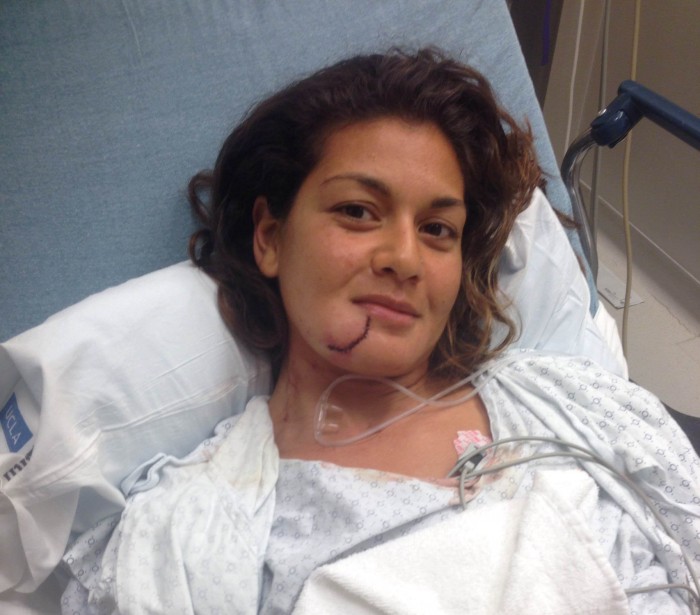Take a moment to observe. What if I said I was born with Autism?
You may feel acceptance and a bit of sympathy.
But what if I say had a mental illness? You may feel yourself separating and judging me as bat shit crazy.
Now, how about this: what if I told you I live with Borderline Personality Disorder (BPD) and am a recovering addict, co-dependent, love addict, and survivor of domestic abuse and sexual trauma?
This is my story about recovery from BPD, addiction and how yoga helped free me from my chains.
What is Borderline Personality Disorder?
By definition, Borderline Personality Disorder is a disorder where individuals have extreme difficulties regulating their emotions. Problems include: intense anger, chaotic relationships, impulsivity, unstable sense of self, suicide attempts, self-harm, shame, fears of abandonment and chronic feelings of emptiness.
People with BPD often have other diagnoses as well. This is called co-morbidity or having co-occurring disorders. Common co-occurring disorders include: substance abuse, eating disorders, anxiety disorders, bipolar disorder as well as other personality disorders. And over half of the BPD population suffers from Major Depressive Disorder.
My childhood.
I’m not going into too much detail of my childhood trauma, but know my childhood environment was less than desirable at times. Family life has something to do with fueling my BPD, and I was born with an innate emotional sensitivity. My parents loved me, but I was often seen as being difficult and stubborn and I do not blame them for how my life unfolded.
In actuality, my family didn’t have the knowledge or tools to help me communicate my needs. On the outside, I was a pretty little girl, outgoing, with the world at her fingertips; but on the inside, I felt alone, misunderstood, was screaming and nobody heard me. As I grew into my 20s, I spiraled into a life of various addictions, abusive relationships and psychotic self-destructive behavior that nearly killed me.
How was I diagnosed?
BPD is not typically visual on the surface. Many people with BPD look and act totally “normal” until emotions are triggered at high levels and an episode erupts.
I went to school, went out with friends, practiced yoga and other exercises, worked a corporate job, but behind closed doors I was being treated for major depression and anxiety disorder. In 2006, after a highly emotional and embarrassing episode involving people close to me, I was called out as emotionally unstable.
Those words made me look up “emotional instability” on the internet. There in black and white, many of my destructive actions and thoughts read as Borderline Personality Disorder. Finally, there was an explanation of what was “wrong” with me, and I sought therapists who specialized in BPD.
F*cking-A to namaste: the real healing begins in Dialectical Behavior Therapy (DBT).
After two years of twice weekly therapy, gaining knowledge about BPD, yoga three times per week and the practice of living mindfully, my distress fluctuated.
By the time I turned 28, my love addiction was well formed in a two year destructive, provoking and invalidating relationship. The suffering intensified and my healing process came to a halt. I struggled to survive and my psychotic episodes were at a constant.
On a Thursday, with nothing out of the ordinary, I came home from work feeling calm and began to plan my death with the goal to die within 24 hours.
However, something told me I was suppose to survive to see age 30, and there had to be help out there.
I researched specialized treatment, left my job and spent the next nine months in an intensive outpatient therapy called Dialectical Behavior Therapy. DBT uses Zen principles and a mindfulness approach to Cognitive Therapy. It, in combination with my continued yoga practice, saved my life.
In DBT, I learned how to create the person I wanted to be from a clean slate.
I had to unlearn all of my old behaviors to create new, healthy ways of coping. It was a full time job in itself. Once I began getting to the core, which for me was physical pain, anger and rage, I hit a plateau. Plateaus are dangerous because Borderlines can experience the most difficultly in this part of recovery, therefore the suicide rate is at its highest.
Shortly thereafter, my relationship provoked an episode that took me to near death.
That moment, I chose to physically leave my toxic relationship knowing it was the only way I had a chance to survive.
Breaking through.
The residue of my relationship triggered me to come face to face with my biggest demons. Only this time, I had the space to use my learned DBT skills to cope with my emotions.
All I wanted to do was run, but my path to recovery had already come too far.
Every emotion I’d ever felt came at me all at once, and I began fighting for my life. Through panic, crawling, screaming and crying, I stayed with the intensity, and then, something suddenly shifted.
The emotions, as I had learned in DBT, changed, and I knew I had defeated my biggest demon.
I was so emotionally exhausted, but I knew life as I knew it was over, and I had made it to the other side. That was the first night I slept knowing real peace.
Now at age 34, it’s been six years since my last psychotic episode, and eight years in sustainable recovery from BPD and addiction.
Oh don’t get me wrong, I’m still human, make mistakes and sometimes revisit old tendencies, but I now have the tools to deal with humility, love and compassion for myself in order to keep moving forward on this side of life.
Yoga and BPD.
Yoga had been the only steady in my life for seven years before I was diagnosed.
Yoga brought relief during my suffering and I began to learn to love myself. My main instructor at the time, Govind Das introduced me to Bhakti Yoga (Yoga of Devotion). This form of Power Yoga, chanting and dancing, is where my genuine self was revealed and I was freed from my chains and led to a path to heal others.
In 2009, I went into teacher training with Tamal Dodge of Yoga Salt. Training was another challenge in itself. I was still healing and didn’t know if I’d even have the strength to guide others while in recovery. However, the more secure I felt in my recovery and teaching, the more I envisioned creating a safe haven for people to practice in a non-competitive and non-judgmental space.
In 2010, I founded The Yoga Place (TYP), beginning with 10 classes, and teaching all of them for nearly a year. I hired my first instructors in April 2011, and today TYP has blossomed into a studio where our instructors and students alike have created a safe space for our community where we are who we are, flaws and all.

Why Share this with you?
In December 2013, my second love, surfing, brought me to face trauma once again.
My surfboard hit me so hard in the face, my chin was split open needing 29 stitches. One month post-concussion, I was feeling FINE (F*cked up, Insecure, Neurotic and Emotional) and the real trauma surfaced.
Not only was my face ripped open, but I was ripped open.
Since then, many challenges have come up mentally, physically and emotionally, and I made the choice to honor my struggles, seeking help from various forms of healing.
My accident prompted me to reveal to you the truth about who I am because I no longer feel ashamed about my past. The experience has reinstated my purpose in life, but to new levels and the scar across my chin is a daily reminder.
It’s likely at some point you have gone through your own trauma and have had to work through physical, mental or emotional wounds, big or small. It’s time I help bring awareness and educate people about BPD, addiction and recovery of any kind.
My experiences have prompted me to expand TYP into a yoga center for wellness where we can include classes specifically designed for people in recovery, trauma and addiction.
The once dormant parts within me, are continuously inspired to stay on my path to healing through yoga and other healing practices.
Love elephant and want to go steady?
Sign up for our (curated) daily and weekly newsletters!
Apprentice Editor: Sarah Qureshi/Editor: Travis May
Photo: provided by author












Read 17 comments and reply